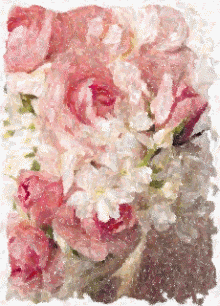
Fifteen students were seated at large tables that had been arranged in a U-shape in the classroom. At the front of the class stood the teacher beside his desk. In the very center of this large room was a table. Atop it was a crystal vase filled with colorful flowers of different varieties. Around the bottom of the vase, a linen cloth had been carefully draped. The students awaited the instructions from the teacher. He spoke to them. His directions were simple. He told the students to paint what they saw on that table centered in the room. The paintings had to be completed by the end of the class. There were no questions asked by those in attendance. The only sounds were the rustlings of watercolor paints being retrieved from art bags, water bowls being filled, pencils scratching the surface of the watercolor paper, the tapping of paintbrushes against the rim of the bowls, an occasional murmuring from some of the would-be artists. Just shy of two hours later, the instructor approached a student and raised her painting to show the others. It was a lovely painting. The flowers sprang from the paper in vibrant colors. The glass vase clearly showed the water it held, as well as the stems of the flowers. The white linen cloth with its folds was depicted nicely. He moved to the next student. His painting was held up to the class. Interesting. His flowers were painted in muted colors. The linen not white but a soft shade of blue. The stems of the flowers could barely be seen inside the vase, just a blur of the palest of greens. The teacher continued his trek around the room holding up each of the students' paintings for all to see. Odd. There was not a single painting among the fifteen that was alike.How could that be? Puzzled expressions settled on the faces of the painters. The last painting having been displayed, the teacher returned to his desk. He asked the class what all of the paintings had in common. One person said they were all paintings of the vase of flowers. The teacher nodded. "What else was alike?" he asked. Noticeable shifting occurred at that time, because it was a real stretch to find anything similar other than the subject matter of the paintings. When no answer was forthcoming, the teacher spoke. The paintings were all alike in that they were different. And what would cause that to be the case? There would be different levels of painting skill among the artists, and their abilities would show. Shadows from the light would be in different places according to the spot where the students viewed the vase. Some people may have had an aversion to a particular color or flower and chose to downplay or even remove its presence from the vase. Some saw the flowers through their minds' eyes in an abstract way, while others saw a more realistic view. Some are stubborn and only wish to paint their own way. Some have a fondness for bright colors, while others prefer pastel shades. The more the teacher spoke, the more reasons for the differences were mentioned by the students. The teacher summed it up by saying that each individual had his/her own unique vision of that lone vase of flowers. They put their pencils and brushes to their paper and sketched then painted what they saw. Because of each person's preferences, abilities, placement in the room, previous instructions from former teachers, likes and dislikes, personality traits, choices, preconceived ideas, the result was fifteen completely different paintings of the same object. And none were "wrong." Fascinating to me when that occurred. Now, apply that to the people around you. What are they seeing? What are you seeing? I would venture to say that no one is seeing the same thing. They might think they are, but they each have their own version of it. Small differences, large differences...but differences nevertheless. You simply cannot take away the individuality of people and expect them to see things in an identical way. You can try, but you will fail. All that we have experienced in our lives colors how we view everything. Since no one has had the exact same life as anyone else, how can they see through anyone else's eyes? We can attempt and perhaps succeed in some small part, but it eventually comes back to what you, yourself, see. Some people need glasses. Others have keen vision. And the only thing you can maybe agree on is that no one is really wrong. It is all about perception and what life experiences we put into our perception. "There are always flowers for those who want to see them." ~Henri Matisse





5 comments:
That was very insightful and open. I really do believe that we all see things different that is why sharing with each other is so important. I loved your entry.
Sharing is a good thing. I am getting better at it.
I agree with your entry and love the visual example. I keep telling my husband "let's agree to disagree." LOL
Nikki!!!!!!
Bravo.
This is well written and worthy of submission.
Aha! Bedazzzled is "NIKKI?" Hehehe
Annnyway ... A story well told. I've had thoughts similiar to this ... being confused and amazed at the variety of experiences people will sometimes tell us that have gone into their making or mix. I think the message of perception is taken here like remembering in church long ago, that the pastor would tell similar stories until he seemed to become familiar to my brain. Unfortunately, I didn't like the person who was trying to get in. But I had heard enough about Jesus to keep him. But then, according to your thesis, we all look at him different. We could say Jesus loves us. Though this belief we are held together in our chistianity, but I sure wouldn't trust George B. in a Texas gunshop! Pretty different, you are so right.
Very, very good entry umm "Nikki?"
Ann (no e)
Post a Comment